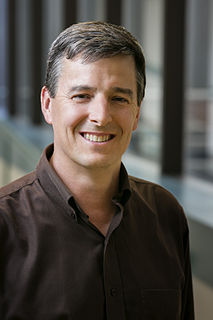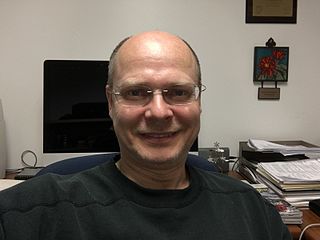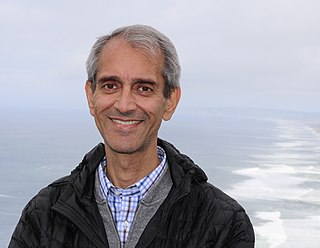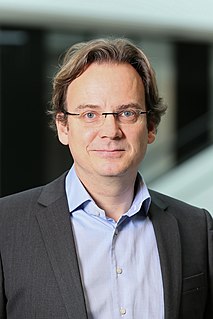
Bionics or biologically inspired engineering is the application of biological methods and systems found in nature to the study and design of engineering systems and modern technology.
Biorobotics is an interdisciplinary science that combines the fields of biomedical engineering, cybernetics, and robotics to develop new technologies that integrate biology with mechanical systems to develop more efficient communication, alter genetic information, and create machines that imitate biological systems.
Rahul Sarpeshkar is the Thomas E. Kurtz Professor and a professor of engineering, professor of physics, professor of microbiology & immunology, and professor of molecular and systems biology at Dartmouth. Sarpeshkar, whose interdisciplinary work is in bioengineering, electrical engineering, quantum physics, and biophysics, is the inaugural chair of the William H. Neukom cluster of computational science, which focuses on analog, quantum, and biological computation. The clusters, designed by faculty from across the institution to address major global challenges, are part of President Philip Hanlon’s vision for strengthening academic excellence at Dartmouth. Prior to Dartmouth, Sarpeshkar was a tenured professor at the Massachusetts Institute of Technology and led the Analog Circuits and Biological Systems Group. He is now also a visiting scientist at MIT's Research Laboratory of Electronics.

John A. Rogers is a physical chemist and a materials scientist. He is currently the Louis Simpson and Kimberly Querrey Professor of Materials Science and Engineering, Biomedical Engineering, and Neurological Surgery at Northwestern University.

Metin Sitti is the Director of the Physical Intelligence Department at the Max Planck Institute for Intelligent Systems in Stuttgart, he founded the department in 2014. He is also a Professor in the Department of Information Technology and Electrical Engineering at ETH Zurich, a Professor at the School of Medicine and College of Engineering at Koç University and co-founder of nanoGriptech Inc. based in Pittsburgh, USA.

Biological engineering or bioengineering is the application of principles of biology and the tools of engineering to create usable, tangible, economically-viable products. Biological engineering employs knowledge and expertise from a number of pure and applied sciences, such as mass and heat transfer, kinetics, biocatalysts, biomechanics, bioinformatics, separation and purification processes, bioreactor design, surface science, fluid mechanics, thermodynamics, and polymer science. It is used in the design of medical devices, diagnostic equipment, biocompatible materials, renewable energy, ecological engineering, agricultural engineering, process engineering and catalysis, and other areas that improve the living standards of societies.
Daniela L. Rus is a Romanian-American roboticist, the Director of the MIT Computer Science and Artificial Intelligence Laboratory (CSAIL), and Andrew and Erna Viterbi Professor in the Department of Electrical Engineering and Computer Science (EECS) at the Massachusetts Institute of Technology.

Bio-inspired robotic locomotion is a fairly new subcategory of bio-inspired design. It is about learning concepts from nature and applying them to the design of real-world engineered systems. More specifically, this field is about making robots that are inspired by biological systems. Biomimicry and bio-inspired design are sometimes confused. Biomimicry is copying from nature while bio-inspired design is learning from nature and making a mechanism that is simpler and more effective than the system observed in nature. Biomimicry has led to the development of a different branch of robotics called soft robotics. The biological systems have been optimized for specific tasks according to their habitat. However, they are multifunctional and are not designed for only one specific functionality. Bio-inspired robotics is about studying biological systems, and look for the mechanisms that may solve a problem in the engineering field. The designer should then try to simplify and enhance that mechanism for the specific task of interest. Bio-inspired roboticists are usually interested in biosensors, bioactuators, or biomaterials. Most of the robots have some type of locomotion system. Thus, in this article different modes of animal locomotion and few examples of the corresponding bio-inspired robots are introduced.

John Oluseun Dabiri is a Nigerian-American aeronautics engineer and the Centennial Chair Professor at the California Institute of Technology (Caltech), with appointments in the Graduate Aerospace Laboratories (GALCIT) and Mechanical Engineering. His research focuses on unsteady fluid mechanics and flow physics, with particular emphasis on topics relevant to biology, energy, and the environment. He is best known for his research of the hydrodynamics of jellyfish propulsion and the design of a vertical-axis wind farm adapted from schooling fish. He is the director of the Biological Propulsion Laboratory, which examines fluid transport with applications in aquatic locomotion, fluid dynamic energy conversion, and cardiac flows, as well as applying theoretical methods in fluid dynamics and concepts of optimal vortex formation.
Masakatsu G. Fujie is a Japanese scientist who has played a major role in cutting-edge research in biomedical engineering. He has been responsible for many advances in the field of robotics.

Wolfgang Fink is a German-American theoretical physicist. He is currently an Associate Professor and the inaugural Maria & Edward Keonjian Endowed Chair of Microelectronics at the University of Arizona. Fink has joint appointments in the Departments of Electrical & Computer Engineering, Biomedical Engineering, Systems & Industrial Engineering, Aerospace & Mechanical Engineering, and Ophthalmology & Vision Science at the University of Arizona. He is the current Vice President of the Prognostics and Health Management (PHM) Society.

Akhilesh K. Gaharwar is an Indian academic and an associate professor in the Department of Biomedical Engineering at Texas A&M University. The goal of his lab is to understand the cell-nanomaterials interactions and to develop nanoengineered strategies for modulating stem cell behavior for repair and regeneration of damaged tissue.

Krishna V. Shenoy is an American neuroscientist and neuroengineer, holding the innagural Hong Seh and Vivian W. M. Lim Professorship at Stanford University and is an Investigator at the Howard Hughes Medical Institute. He is the Director of the Neural Prosthetics Systems Laboratory and the Co-Director of the Neural Prosthetic Translational Lab along with Professor Jaimie Henderson, MD. He is a member of the Wu Tsai Neuroscience Institute and the Bio-x Institute. Shenoy focuses on motor and computational neuroscience, neuroengineering, brain-machine interfaces (BMIs) / brain-computer interfaces (BCIs) and neurotechnology. He has published over 125 journal articles.
Ellen Roche is an Irish biomedical engineer and Associate Professor at MIT in the Department of Mechanical Engineering and the Institute of Medical Engineering and Science. She has contributed to heart failure prevention with her inventions, the Harvard Ventricular Assist Device (HarVAD), a soft-robotic sleeve device that goes around the heart, squeezing and twisting it to maintain the heart’s functionality, and Therepi, a reservoir that attaches directly to damaged heart tissue.
Philip LeDuc is the William J. Brown Professor at Carnegie Mellon University (CMU) and the Founding Director of its Center for the Mechanics and Engineering of Cellular Systems. He is in the department of Mechanical Engineering, but also has appointments in Biological Sciences, Computational Biology, Biomedical Engineering, and Electrical and Computer Engineering. LeDuc works at the intersection of mechanical engineering and biology.

Auke Jan Ijspeert is a Swiss-Dutch roboticist and neuroscientist. He is a professor of biorobotics in the Institute of Bioengineering at EPFL, École Polytechnique Fédérale de Lausanne, and the head of the Biorobotics Laboratory at the School of Engineering.
Helen Haiyan Lu is a Chinese American biomedical engineer and the Percy K. and Vida L. W. Hudson professor of biomedical engineering at the Columbia University Fu Foundation School of Engineering and Applied Science. Her work focuses on understanding and developing therapies in complex tissue systems, especially the interface between soft tissue and bone.
Mitra J.Z. Hartmann is a professor of mechanical engineering and biomedical engineering at the Robert R. McCormick School of Engineering and Applied Science at Northwestern University. She specializes in robotics, sensory acquisition behaviors, sensorimotor integration, and neuroethology. Her lab focuses on translating sensory signals felt by whiskers to robotics.
Mohsen (MO) Shahinpoor is an Iranian American engineer, scientist, and academician. He is a professor and Director at the University of Maine College of Engineering, Department of Mechanical Engineering. He is also a professor in the Graduate School of Biomedical Science and Engineering at the University of Maine.
Valencia Joyner Koomson is an associate professor in the Department of Electrical and Computer Engineering at the Tufts University School of Engineering. Koomson is also the principal investigator for the Advanced Integrated Circuits and Systems Lab at Tufts University.